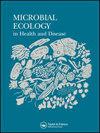Functional food for functional disorders
引用次数: 4
Abstract
Unexplained hypersensitivity to food is a major health problem affecting about 10% of the population, and is often associated with disabling symptoms, such as irritable bowel syndrome (IBS), musculoskeletal pain (fibromyalgia) and fatigue (chronic fatigue syndrome/myalgic encephalomyelitis; CFS/ME). Recent metabolomic studies suggest a hypometabolic state with excessive oxidative stress, impaired oxidative phosphorylation, and an energy production dependent on the metabolism of fat and amino acids.[1] ‘Missing microbes’ [2] following the use of antibiotics at an early age may be an important cause, possibly assisted by a Western diet high in simple carbohydrates.[3] The present preliminary report is the result of a systematic survey of 438 consecutive patients examined by one of us (AB). Validated diagnostic criteria and scoring questionnaires for symptom severity were applied.[4] Briefly, the results are as follows. Age of the patients is on average 37 years; 2/3 are women. Virtually all patients have irritable bowel syndrome (IBS) with symptoms related to incomplete evacuation and altered intestinal fermentation. A selection of the patients who have undergone ultrasonography or MRI scans are found to have increased amount of fluid persisting in bowel loops one hour after the ingestion of lactulose, consistent with intestinal hypomotility.[5,6] Although perceived food intolerance was the ‘entrance ticket’ for medical investigation, IBS was rarely attributable to food allergy. In addition to IBS, about 70% of the patients had musculoskeletal pain and 85% chronic fatigue. About half of those with fatigue met the international criteria for an ME diagnosis, and this diagnosis correlated well with being placed on long-term sick leave. The history of illness averaged 26 years. The first symptoms were almost always related to abdominal discomfort, and very often (in about 90% of the cases) the symptoms appeared after prolonged antibiotic treatment at an early stage of life. Subsequently, the problems deteriorated, often after bouts of gastroenteritis and/or further courses of antibiotic treatment. Our results therefore suggest that both the perceived food hypersensitivity and IBS, acquired following antibiotics at early life, and the subsequently acquired musculoskeletal pain (including temporomandibular dysfunction), chronic fatigue and ME are aspects of one disease, not several different diseases. Seminal studies show loss of lactic acid bacteria and increased growth of yeast (Candida albicans) in the bowel immediately following the use of antibiotics.[7,8] Previously, it was believed that this altered bowel flora would normalise in the course of a week. However, recent studies show that this is not always the case; sometimes the bowel flora never fully recover.[2,9] ‘Missing microbes’ following the use of antibiotics may lead to the growth of unfavourable flora, frequently in the form of a biofilm with yeast and facultatively anaerobic microbes.[10] This biofilm elicits little local damage, but stimulates innate immunity and the release of interferon gamma, which in turn activates indoleamine dioxygenase (IDO) and the metabolism of tryptophan along the kynurenine pathway.[11] The result is an altered immune response with increased immune tolerance, protecting the pathological flora.[12] However, tryptophan is also the precursor of important hormones such as serotonin and melatonin – and increased metabolism of tryptophan to kynurenines may lead to serotonin and melatonin deficiency.[13,14] Shortage of serotonin may explain poor intestinal peristalsis, sadness and ‘brain fog’, while melatonin deficiency may explain poor sleep and the feeling of never being completely refreshed. Increased physical and cognitive fatigue may largely be due to oxidative stress, possibly because a deficiency of lactic acid bacteria may result in excess oxygen levels within the bowel. By producing hydrogen peroxide, these microbes pick up remaining oxygen and thus help to maintain low oxygen tension. If the redox potential is too high, the metabolism of the host switches to an oxidative shielding response [15] with aerobic glycolysis and deficient mitochondrial energy (ATP) production (Crabtree effect).[16] Some important aspects of the treatment are: dietary carbohydrate restriction may reduce IBS symptoms,[17] while commercial probiotic lactobacilli may功能失调的功能性食物
不明原因的食物超敏反应是一个影响约10%人口的主要健康问题,通常与致残症状有关,如肠易激综合征(IBS)、肌肉骨骼疼痛(纤维肌痛)和疲劳(慢性疲劳综合征/肌痛性脑脊髓炎;CFS/ME)。最近的代谢组学研究表明,低代谢状态下氧化应激过度,氧化磷酸化受损,能量产生依赖于脂肪和氨基酸的代谢。[1] 早期使用抗生素后的“微生物缺失”[2]可能是一个重要原因,可能是西方饮食中富含简单碳水化合物。[3] 本初步报告是我们中的一位(AB)对438名连续患者进行系统调查的结果。应用经验证的诊断标准和症状严重程度的评分问卷。[4] 简而言之,结果如下。患者的平均年龄为37岁;2/3是女性。几乎所有患者都患有肠易激综合征(IBS),其症状与肠排空不完全和肠道发酵改变有关。一组经过超声或MRI扫描的患者发现,摄入乳果糖一小时后,肠环中的液体量持续增加,这与肠道运动能力低下一致。[5,6]尽管感知的食物不耐受是医学调查的“入场券”,但IBS很少可归因于食物过敏。除了肠易激综合征,约70%的患者有肌肉骨骼疼痛和85%的慢性疲劳。大约一半的疲劳患者符合脑脊髓炎诊断的国际标准,这一诊断与长期病假密切相关。病史平均26年。最初的症状几乎总是与腹部不适有关,而且通常(约90%的病例)症状是在生命早期经过长期抗生素治疗后出现的。随后,问题恶化,通常是在肠胃炎发作和/或进一步的抗生素治疗之后。因此,我们的研究结果表明,早期服用抗生素后获得的食物超敏反应和IBS,以及随后获得的肌肉骨骼疼痛(包括颞下颌关节紊乱)、慢性疲劳和脑脊髓炎都是一种疾病的方面,而不是几种不同的疾病。神学院研究表明,使用抗生素后,肠道中乳酸菌的减少和酵母(白色念珠菌)的生长增加。[7,8]以前,人们认为这种肠道菌群的改变会在一周内恢复正常。然而,最近的研究表明,情况并非总是如此;有时肠道菌群永远无法完全恢复。[2,9]使用抗生素后的“缺失微生物”可能会导致不利菌群的生长,通常以酵母和兼性厌氧微生物的生物膜形式出现。[10] 这种生物膜几乎不会引起局部损伤,但会刺激先天免疫和干扰素γ的释放,从而激活吲哚胺双加氧酶(IDO)和色氨酸沿犬尿氨酸途径的代谢。[11] 其结果是免疫反应改变,免疫耐受性增强,保护病理菌群。[12] 然而,色氨酸也是血清素和褪黑素等重要激素的前体——色氨酸向犬尿氨酸的代谢增加可能导致血清素和褪黑素缺乏。[13,14]血清素缺乏可能解释肠道蠕动不良、悲伤和“脑雾”,而褪黑激素缺乏可能解释睡眠不足和从未完全恢复的感觉。身体和认知疲劳的增加可能主要是由于氧化应激,可能是因为乳酸菌缺乏可能导致肠道内氧气水平过高。通过产生过氧化氢,这些微生物吸收剩余的氧气,从而有助于保持低氧张力。如果氧化还原电位过高,宿主的代谢会切换到氧化屏蔽反应[15],即有氧糖酵解和线粒体能量(ATP)产生不足(Crabtree效应)。[16] 治疗的一些重要方面是:限制饮食碳水化合物可能会减轻IBS症状[17],而商业益生菌乳酸杆菌可能
本文章由计算机程序翻译,如有差异,请以英文原文为准。
求助全文
约1分钟内获得全文
求助全文

 求助内容:
求助内容: 应助结果提醒方式:
应助结果提醒方式:


